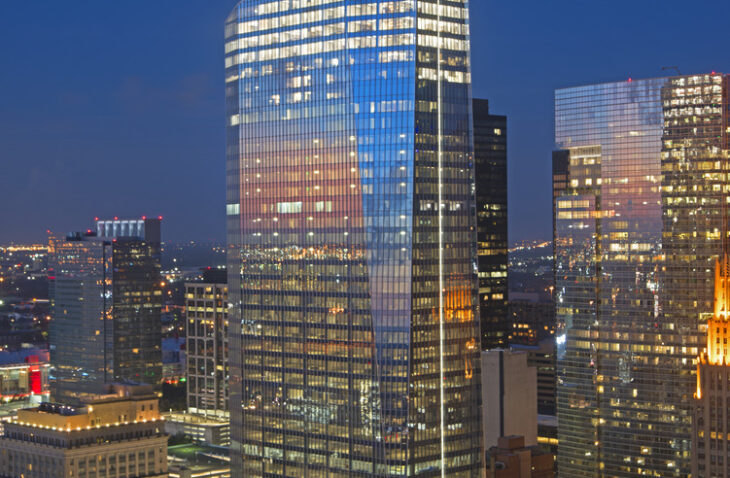New High-Rise Office Building
This one million-sf speculative office building in Houston’s Central Business District is designed to cater to user needs while also meeting the explosive need for Class A office space in an iconic building. The lobby features a soaring pyramid-shaped 110’ clear vertical span. There is also an urban green space sitting atop a 1,500-car integrated garage, with 23,000-sf of outdoor space wrapped around an 8,000-sf interior terrace, also topped by accessible green space. A compact building core and 27,500-sf floorplates is highly flexible and allows daylight deep into the interiors. The 48th floor features a double-height glass roof.
The tower’s geometry posed the biggest structural challenge. The north and south facades each have a vertical crease that appears to make them envelope the west façade. The west façade is narrowest at the bottom and expands up to level 12, where it then gradually contracts up to the roof level, appearing to absorb the “folds” of the adjacent two facades. This geometry created two planes of sloped columns. The first is on the west face of the building; the second is one bay east. Two 76” diameter columns support floors 1-4 on the west side. Floors 5-12 have sloped 52” x 45” columns in conjunction with 48”x 60” diagonal columns, forming two “Y” columns. The structure for the office tower and parking garage consists of cast-in-place concrete systems.
The north and south facades have mirror-image angles at the top, “fins” that extend 75’ above the roof to screen the cooling towers. A separate structural truss system provides lateral support for the fins. Engineers performed wind tunnel studies that showed a 15% greater wind load demand required than specified by code. With the fins, 609 Main reaches a height of 755’.
Below grade are two additional levels of parking and a 70’ pedestrian tunnel providing access under Main Street to the Houston underground pedestrian tunnel system. A 42,000-gallon tank in the basement collects rain and AC condensate for irrigation. Concrete soldier piles were used for temporary retention during basement excavation. With a concrete facing wall, the composite system now acts as the permanent basement wall.
The project was awarded LEED Platinum Certification.









